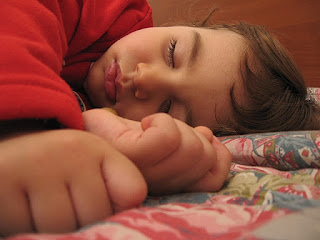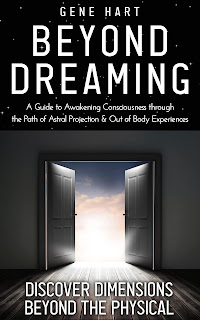Beyond Dreaming
by Gene Hart
Today I'm reviewing Beyond Dreaming: A Guide to Awakening Consciousness through the Path of Astral Projection & Out of Body Experiences by Gene Hart.
I really didn't know anything about author Gene Hart until he suddenly appeared in the Facebook Astral Projection groups a couple years ago. He's contributed a lot to those groups, including his favorite astral projection technique. I didn't find out he had written a book about the subject--this book--until much later.
Early in the book Hart won my, well, "Heart," with quotes like this:
"The realization of one's own ignorance is the beginning of authentic self-knowledge." (pg. 11)
Very true.
If you've read my other book reviews you know that one of my pet peeves is authors who claim to know all about astral projection but don't include any credentials or experience. It's like writing a book about having a successful marriage without actually having been married. When it comes to marriage and astral projection, book knowledge, theories, and hearsay are light-years away from firsthand experience. So early on I applauded Hart when he gave a narrative of his first out-of-body experience from June, 2011 on page 19. He writes:
"...I felt blisteringly alive, but at the same time, heavy and more real than anything I had ever experienced before in my waking life, and definitely more palpable and 'physical' than any of the hundreds of lucid dreams I had beforehand." (pp. 19-20)
So yes, Gene Hart writes from experience, and you can tell it's genuine from his descriptions. And makes a clear distinction between OBEs and lucid dreams.
He describes a decent "validation" OBE:
"So, I went back to my physical body and woke up; I immediately got up and walked to the stairway, and to my great pleasure, I saw the exact same scene. She was standing there in the same location, on her phone, in her pyjamas, holding the blue packet of crisps and sitting next to the same friend I saw [in my OBE]. I smiled with an inner knowing and satisfaction." (pg. 35)
One chapter was called "The Dream of Life" and I was a bit confused by statements like this:
"As psychologists notoriously recognize, and what is spilled over into conventional wisdom, is that dreams are usually about the things we did while we were awake. They are simply a reflection of our waking lives. If this is true, one could possibly say it is safe to assume that if you do not dream while awake, then you won't dream while asleep too. In other words, if you are conscious while awake, then you'll be conscious while asleep; this is a cord teaching in this book." (pg. 37)
I could be wrong, but I think what Hart is trying to say is that our conscious experience is a combination of our perceptions, degree of lucidity, and our interpretations of those perceptions, and that dreams are interpretations of false perceptions, and that can happen whether we're awake or asleep. In other words, you can dream while awake, just as you can dream while asleep. And you can have perceptions of an objective reality while awake or asleep. Perhaps it's a new spin on my theory about the Four out-of-body states? I bet Gene and I could have several hours-long conversations about it.
If you want to have out-of-body experiences, Hart says we need to take it very seriously:
"This is why we have to address our lives, and not just astral projection as a sort of separate hobby or casual interest. It is a wholesome practice that it affects us positively and profoundly on every level of our Being. Observe any Kung Fu Master; he does not just partake in his martial arts every now and then for fun, no. He takes it seriously, and he lives his life through the philosophy his martial art teaches just as much as when he is fighting. He grows and builds his character as a result. The path of astral projection is absolutely the same, if not more." (pp 45-46)
I agree. The more seriously you take this, the better your chances of success.
Sprinkled throughout the book are quotes from various spiritual teachers like Carlos Castaneda, H.P. Blavatsky, and surprisingly, Samael Aun Weor, author of one of the worst books I've ever read and reviewed, Dream Yoga. Many of the other quotes were excellent, such as:
"We either make ourselves miserable, or we make ourselves strong. The amount of work is the same." (Don Juan Matus (via Carlos Castaneda) pg. 98)
Unlike most authors, Hart talks about spiritual classes that we can attend in out-of-body states, whether conscious or unconscious. Like Hart, I have experienced this firsthand:
"A significant thing I learned from this experience was that the way we are influenced at night is not by intellectual learning but by things that make a powerful impression on our consciousness. This is how influential OBEs can be on our subconscious at night and why it can be of great spiritual significance to become aware of what is happening in our sleep. I believe many of us unconsciously attend these sorts of classes during sleep more often than we realise." (pg. 56)
To be quite blunt, the book is not heavy on techniques. In fact, it leans more toward throwing out the techniques to focus instead on other influencing factors. He does, however, give some good solid practical advice, such as:
"Another sort of reality check is a more active one that we can develop in our everyday perception of the world, which I call 'reality-checking awareness'. This can be done by 'looking around corners' or 'opening doors', or looking anywhere really...To do this, whenever you walk around a corner of your house, take a moment in your mind to recall what should be around the corner, remember what it should look like, note details, objects, colours etc. Then when you walk around the corner and examine if everything is the same as you had expected. Is anything different? Are the walls the same color? Does the clock have the correct time on it? Is someone in the room that you didn't expect? If something is out of place, then confirm it with a reality check, hold your nose and try to breathe through it. If you do this enough times daily, you will unquestionably find yourself doing it subconsciously in your dreams out of habit." (pp. 69-70)
One of my favorite chapters was "Meditation as a Prerequisite to Astral Projection." He recommends:
"Just one way to enter a more present way of life is by making a habit of noticing the silence between sounds, and also observing the space between objects; thus, inner silence, and inner space, arise naturally." (pp. 81-82)
Hart doesn't offer many exit techniques, but he does give a few. He gives instructions for Wake Back to Bed (WBTB), and it's a pretty good explanation. He also gives some mantras for OBEs, such as FA RA ON" and "LA RA S" as per V.M. Beelzebub's much older book.
He focuses on key skills more than techniques; skills such as meditation, and to allow it to happen naturally. I loved this analogy:
"Meditation alone is like become [sic--becoming?] an incense stick, and prayer is actually lighting the incense stick--or meditation is like becoming a singing bowl, and prayer is actually singing the bowl." (pg. 83)
Another good example is a section in which he recommends you "Cultivate Unbending Intent." (pg. 110). How do you do that? Well, in part:
"Continue your love, curiosity, passion and interest for astral projection; devote yourself, pray, meditate and penetrate it to every core of your being and leave no room for doubt." (pg. 111)
Before his first OBE, Hart was apparently an avid lucid dreamer, so it's natural that he promotes one of the more popular OBE techniques: induce a Lucid Dream and turn it into an OBE. His technique to convert from LD to OBE is called "The Flying Method" and it's basically flying "intensely" upwards until you feel OBE exit sensations, such as the vibrations (pg. 92).
He does, however, offer good advice about meditation and quieting the mind. I loved this description:
"Eventually, as you meditate and go beyond all the forms and objects in your consciousness, there will come a point amongst the quietude of nothingness, like the cracking of a shell, where you will find yourself in another reality." (pg. 130)
Throughout the book, Hart tries to convince us that we should not focus on exit techniques, but instead work on ourselves.
"My personal; message is that if you genuinely want to experience the reality of the astral in its depths, you must commit to working on the awakening of consciousness every day, not just for yourself but for others...."
"If you work on yourself, you'll eventually have astral projection experiences which are naturally longer and more profound. This is the real art and practice of astral projection; the experience is given to you by grace when you put in the real human work--not by following simple step-by-step experiments as a half-hearted curious individual." (pg. 147)
At the end of the book, Hart has a short list of recommended reading, and he recommends my book, Hacking the Out of Body Experience. I did not expect that, but I'll take it. Thanks for the mention.
So where does Beyond Dreaming lie in the grand scheme of things? My first book, Out of Body Experiences, was geared toward "This is what happened and these are my observations." My second book, Lessons Out of the Body, was more spiritual and geared toward "This is what OBEs can teach us spiritually." Beyond Dreaming is kind of halfway between the two. It's a good balance, often leaning toward the spiritual and philosophical side of things.
He could have given more techniques, tips and suggestions. He could have given more firsthand OBE narratives. He could have doubled the size of the book. I wish he had.
The book is 160 pages and the margins and font is good, meaning there's enough content to satisfy. It's well written, concise, thoughtful and, well, spiritual. There are more technique-heavy books like Hacking. There are "deeper" books like Multidimensional Man. There are more entertaining books like Clary Valentine's An Adjacent Place. But I definitely enjoyed Beyond Dreaming a lot. I'm giving it 4 stars out of 5.
Bob Peterson
27 September 2022
----------------------------
If you want me to review
a book about out-of-body experiences or astral projection, send me an
email: bob@robertpeterson.org, but please check the index first to see
if I've already reviewed it. Also, I've got a huge pile of books I'm
planning to review, so don't expect a quick turnaround.
If you like my work, visit my website, robertpeterson.org, where you'll find lots of other free OBE advice and links.

















































